Lactuca orientalis is a Eurasian species of plant in the tribe Cichorieae within the family Asteraceae. It is widespread across the Middle East and southern Asia as far east as Tibet.

Lactuca muralis, the wall lettuce, is a perennial flowering plant in the tribe Cichorieae within the family Asteraceae, also referred to as Mycelis muralis.
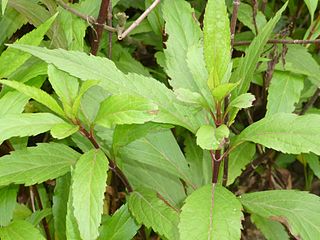
Eupatorium fortunei is a plant species in the family Asteraceae native from Asia where it is rare in the wild but commonly cultivated. The white to reddish colored flowers and herbage smell like lavender when crushed. In China the plants are used to make fragrant oils.

Eupatorium japonicum, known as fragrant eupatorium in English and 白头婆 bai tou po, in Chinese, is a herbaceous plant species in the family Asteraceae. It is native to China, Japan and Korea.

Warionia is a genus in the tribe Cichorieae within the family Asteraceae. The only known species is Warionia saharae, an endemic of Algeria and Morocco, and it is locally known in the Berber language as afessas, abessas or tazart n-îfiss. It is an aromatic, thistle-like shrub of ½–2 m high, that contains a white latex, and has fleshy, pinnately divided, wavy leaves. It is not thorny or prickly. The aggregate flower heads contain yellow disk florets. It flowers from April till June. Because Warionia is deviant in many respects from any other Asteraceae, different scholars have placed it hesitantly in the Cardueae, Gundelieae, Mutisieae, but now genetic analysis positions it as the sister group to all other Cichorieae.
Cavea is a low perennial herbaceous plant that is assigned to the family Asteraceae. Cavea tanguensis is currently the only species assigned to this genus. It has a basal rosette of entire, slightly leathery leaves, and stems of 5–25 cm high, topped by bowl-shaped flower heads with many slender florets with long pappus and purplish corollas. The vernacular name in Chinese is 葶菊. It grows high in the mountains of China (Sichuan), Tibet, India (Sikkim), and Bhutan, and flowers in July and August.
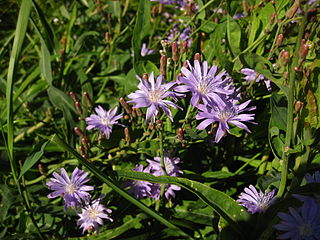
Lactuca tatarica, known as blue lettuce, is a Eurasian flowering plant in the tribe Cichorieae within the family Asteraceae. It is widespread across much of Europe and Asia.

Lactuca viminea, the pliant lettuce, is a Eurasian plant species in the tribe Cichorieae within the family Asteraceae. It is widespread across much of Europe and southwestern Asia from Portugal to Pakistan.
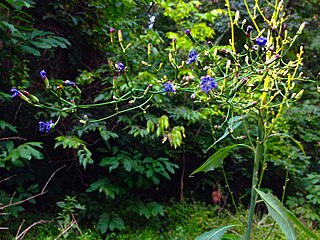
Lactuca floridana, commonly known as woodland lettuce, Florida lettuce, or false lettuce is a North American species of wild lettuce. It is native across much of central Canada and the eastern and central United States.

Felicia echinata, commonly known as the dune daisy or prickly felicia, is a species of shrub native to South Africa belonging to the daisy family. It grows to 1 m (3.3 ft) high and bears blue-purple flower heads with yellow central discs. In the wild, it flowers April to October.
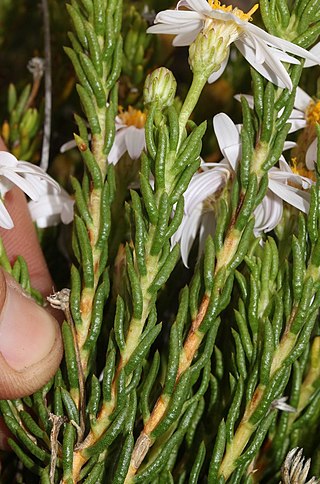
Felicia oleosa is an evergreen, richly branched dwarf shrub of up to 30 cm (12 in) high, that is assigned to the family Asteraceae. It has narrow, awl-shaped leaves, with translucent oil or resin dots, pointing upwards, crowded on the younger stems. The flower heads have about thirteen bright blue ray florets, encircling many yellow disc florets. This species grows in the mountains dividing the Karoo region of South Africa. It is sometimes called oily blue daisy in English.

Felicia nordenstamii is a flowering shrub in the family Asteraceae. It is found only in South Africa where it grows on limestone hills close to the sea on the southern coast. Felicia nordenstamii is a many-branched shrub growing up to 30 cm (1 ft) tall. The lower parts of the stems are covered in grayish brown bark and the upper stem has many crowded, upwardly angled, alternate leaves with long hairs on the lower surfaces. Large flower heads form at the tips of the branches, each about 41⁄2 cm across, with about thirty purplish blue ray florets surrounding many yellow disc florets.
Felicia annectens is an annual plant of up to about 25 cm (10 in) high, that is assigned to the family Asteraceae. The lower leaves are opposite and the higher leaves alternate. The bloated involucre consists of very broad, hairless bracts. These protect up to ten, short, bluish ray florets that encircle yellow, partly sterile disc florets. The heads sit individually on top of up to 6 cm long stalks. The species was considered extinct after no observations were made after 1915, but was rediscovered in the 21st century. It occurs in the Western Cape province of South Africa.

Felicia bergeriana is a richly branching, hairy annual plant of up to 25 cm (10 in) high that is assigned to the family Asteraceae. It has opposite leaves and flower heads set individually on up to 8 cm long stalks, that consist of an involucre of about 1⁄2 cm diameter with two whorls of bracts, about twelve blue ray florets surrounding more yellow disc florets. It is sometimes called kingfisher daisy in English. It can be found in the Northern and Western Cape provinces of South Africa. It is sometimes cultivated as an ornamental.

Felicia mossamedensis or yellow felicia is a well-branched, roughly hairy, annual or perennial plant of up to 30 cm (1 ft) high, assigned to the family Asteraceae. It has alternately arranged, seated, flat to slightly succulent, broad-based, entire, blunt tipped leaves. The flower heads sit individually on top of a stalk of up to 8 cm (3 in) long, have an involucre of three whorls of bracts, many yellow ray florets and many yellow disk florets. It can be found in southern Africa, in Zimbabwe, Mozambique, Botswana, Eswatini, South Africa and on the coast of Angola.

Symphyotrichum racemosum is a species of flowering plant native to parts of the United States and introduced in Canada. It is known as smooth white oldfield aster and small white aster. It is a perennial, herbaceous plant in the family Asteraceae. It is a late-summer and fall blooming flower.
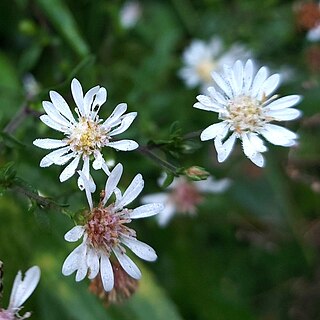
Symphyotrichum schaffneri is a perennial, herbaceous species of flowering plant in the family Asteraceae native to the states of Puebla and Veracruz, Mexico.
Jeffreycia is a genus of African flowering plants in the family Asteraceae. They are in the tribe Vernonieae.
Zanthoxylum esquirolii is a woody plant in the family Rutaceae from Guizhou, Sichuan, and Yunnan China.

Symphyotrichum kentuckiense is a rare species of flowering plant in the Asteraceae family and is commonly known as Kentucky aster, Price's aster, Miss Price's aster, Sadie's aster, or lavender oldfield aster. It is a perennial, herbaceous plant that is endemic to broken limestone cedar glades and roadsides in Alabama, Georgia, Kentucky, and Tennessee. It blooms from August through October, reaches heights between 30 centimeters and 100 cm (3.3 ft), and has green to reddish-brown stems. It is a nearly hairless plant with blue to blue-violet ray florets.















